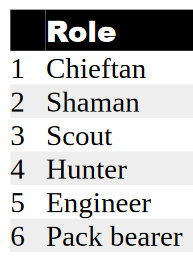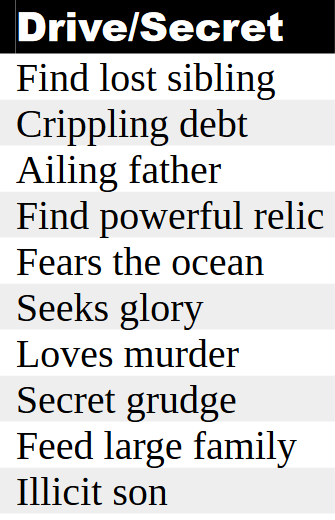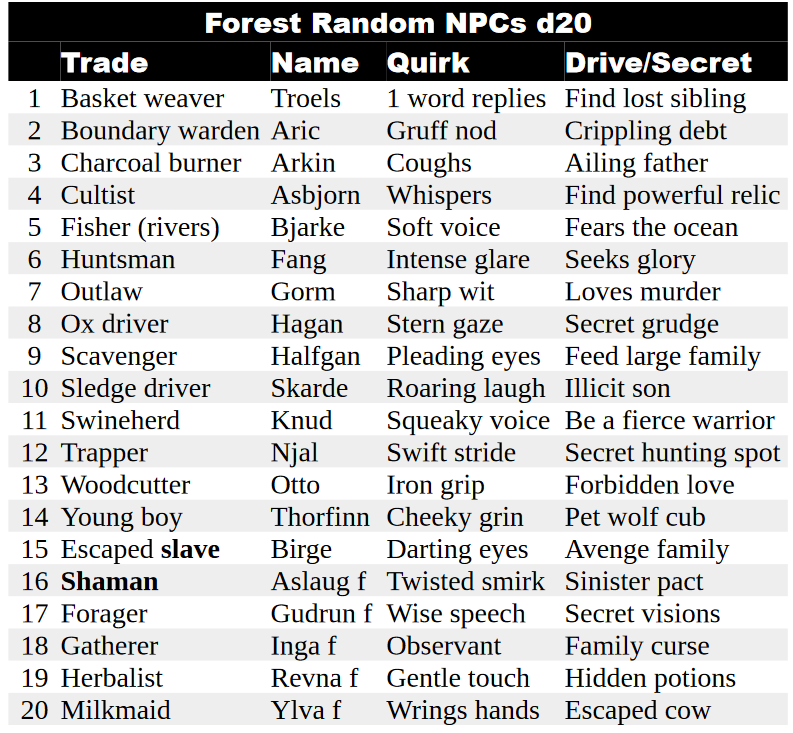1: Think Beyond Combat
Random encounter tables can be great fun. When I made a random encounter table I want the results to be interesting and unusual and to facilitate different kinds of challenges and experiences for the players.
I like players responding creatively to challenges, so I include elements that make that more likely. Anything that breaks the party out of…here’s a monster…roll for initiative…fight until the monster is dead.
2: Give Monsters or NPCs a Name & a Role
If it’s a group of monsters or NPCs you can give the leader and a key member a name and a role. This encourages roleplaying and an interaction beyond just combat.

If they’re NPCs or the monsters have some kind of structure to their society then having a role or trade for one or two of them makes them interesting too and much easier to roleplay if you’re the GM.
An orc engineer called Morguk is much easier to roleplay than an orc with no name and no role and it only takes two words in a table to give you that raw material to work with.
With NPCs and monsters a role or trade can define who they are. It will also have a huge bearing on how they act.

Just a name and a role can light up your imagination. In the case of our orc engineer he might be smaller but smarter than the other orcs. The pack bearer might have ambition to rise through the ranks or be totally pissed at everyone in the orc warband.
Their motivations will vary widely from one orc to the other and that leads us to number 3…
3: Create Motivations or Secrets
When a monster or an NPC has its own distinct motivation or secret, that creates information that could be valuable to the player characters.
Can they talk their way out of an encounter by finding out what a powerful monster wants? Can they get a group of monsters fighting with each other by taking advantage of their conflicting motivations or secrets?
Can a monster or an NPCs motivation or secret lead to an exciting adventure for the party or a side goal on their current adventure? Can it link to what becomes an overarching adventure or villain in the future?
Here’s an example of a list of NPC motivations or secrets. Just two or three words in a table can add so much depth…

4: Quirks Are Fun
You can add flavour to any monster or NPC by giving them a personality quirk.
The orc who snorts at the end of a sentence or cleans his nails with a huge dagger made of human bone while he talks adds flavor to his interaction with player characters.
NPC quirks can also make interactions interesting and engaging. Combined with a trade, a name, and a motivation or secret you get an NPC that is easy to roleplay for the GM and can lead on to adventures, side goals, or a whole range of other possibilities.
What happened to Ylva the milkmaid’s cow? Will you help her find it and save her being beaten by her master, or will whatever ate her cow end up finding you?
Will you let Knud the swineherd with a squeaky voice join your party so he can fulfill his dream of becoming a great warrior or will you thrash him in a practice duel and convince him his dream will just end with him dead in the corner of some smelly, dark dungeon?

Even monsters that don’t talk might have quirks. A large monster might regurgitate shields and armor of a warrior it ate recently.
5: What Are The Monsters Doing?
Monsters don’t just sit around waiting for the player characters to arrive. If they were waiting for them then that would most likely be an ambush.
They might be torturing a hostage, have someone trapped, chasing after another animal trying to eat it, playing some kind of gambling game, about to cook up a victim they captured, or having a duel to see who is going to be chief etc. etc.
Including a list of things monsters are doing in your random encounter table or having another table for what monsters are doing can add some fun and depth to your encounters.
6: Think About Table Size d6, 2d6, d20, d6|6 (d36)?
Some people suggest using a 2d6 encounter table but it’s not my personal preference because I want a lot of varied encounters….not the same encounter happening over and over.
If you wanted a lot of encounters with the same kinds of monsters it would probably be better to have multiple encounters of the same kind of monster but with different elements (like different motivations for the monsters, different quirks, different things they’re doing etc.)
If you had a d20 table instead of a 2d6 table you could use those extra spaces. So instead of writing: 1-4 goblins, you could have a different entry for each different kind of goblin encounter.
If you’re making an encounter table for a specific dungeon or region, and you want something that’s quick and easy to make, a d6 table will do it.
You could even not bother rolling, just start with the encounter at the top of the table and go to the bottom one at a time. You could design the encounters so that the party meets monsters or NPCs with increasing levels of valuable knowledge the further down the table they get.
Also remember with random encounter tables you can choose the most appropriate encounter for a specific situation. You don’t need to let the dice decide every time. Go ahead and use that super cool encounter you designed if it doesn’t look like you’ll have another chance.
If you want a table with huge variety a d20 table is great and if you want something you can use for years d6|6 tables with 36 different entries will do that.
7: If You’re Having Fun You’re Doing It Right
This is really just a list of ideas and suggestions. If you and the people at your table are having fun then keep doing what you’re doing.
There is no right and wrong in table top role playing games. If you’re having fun then it’s working!
Leave a Reply